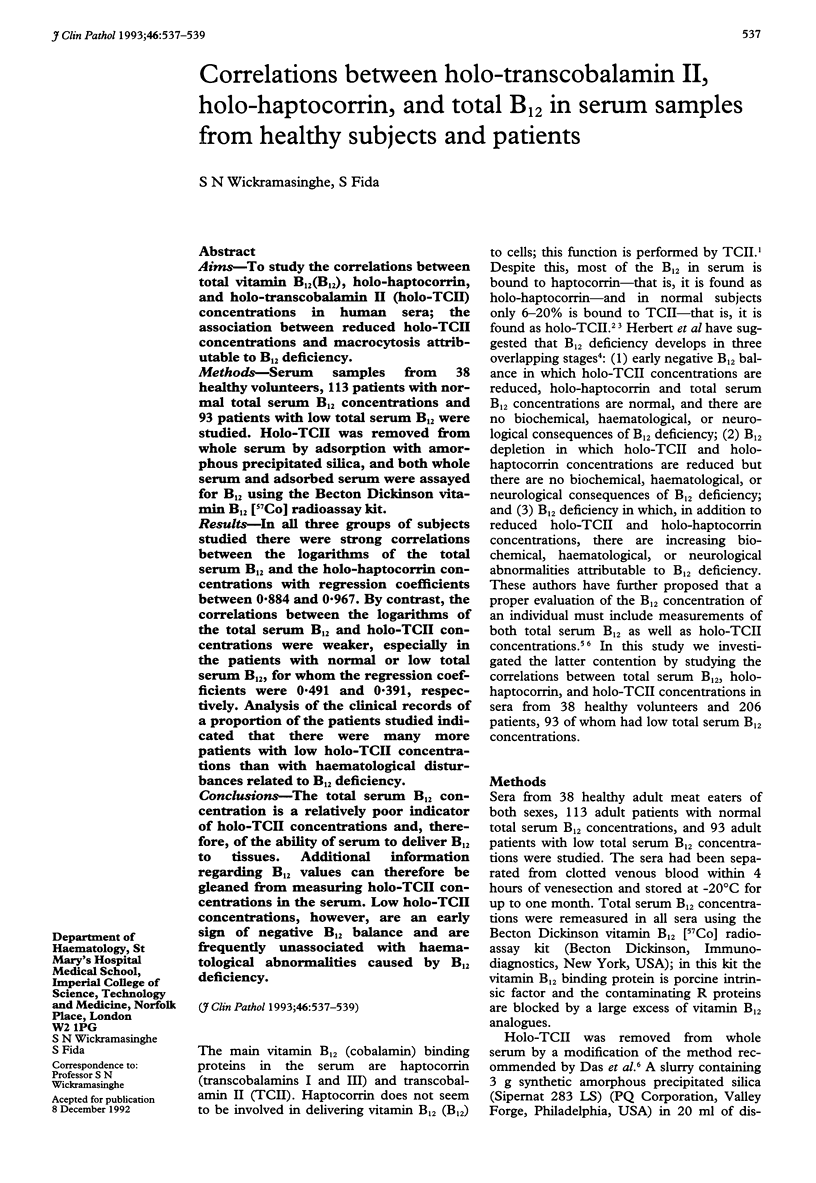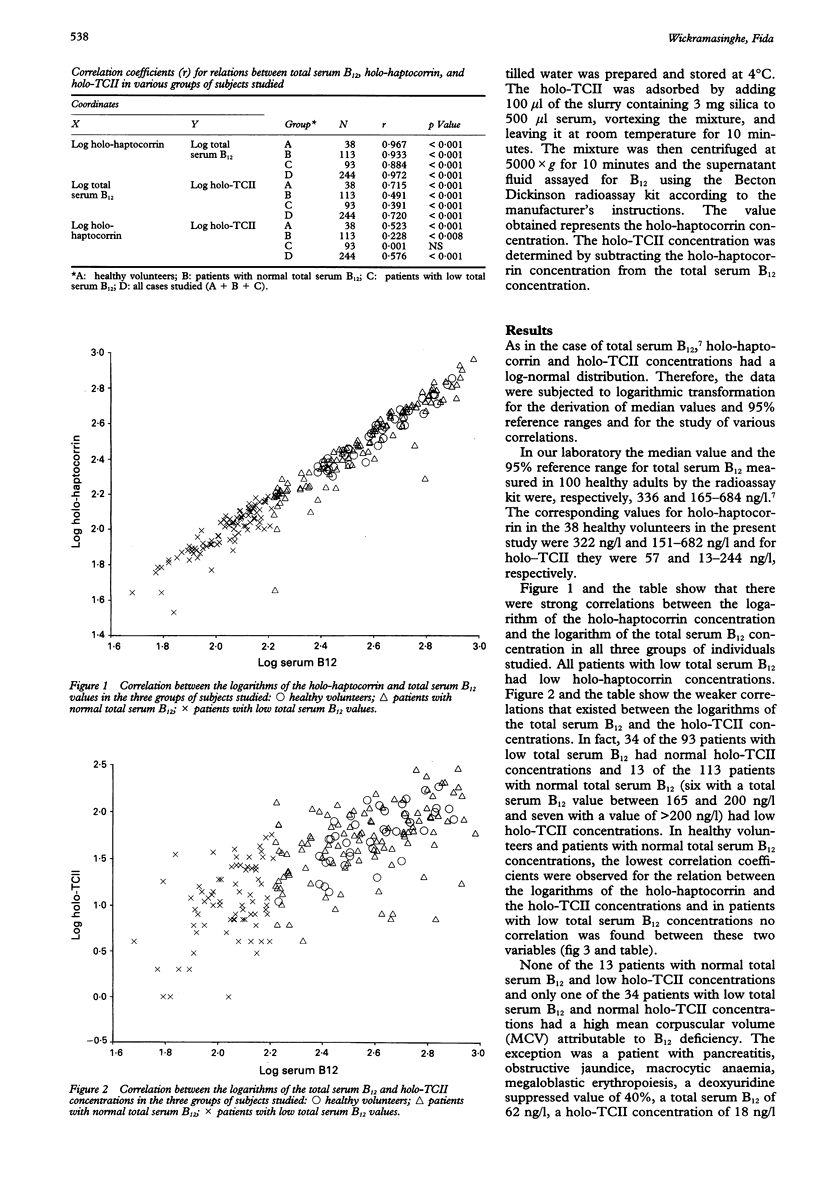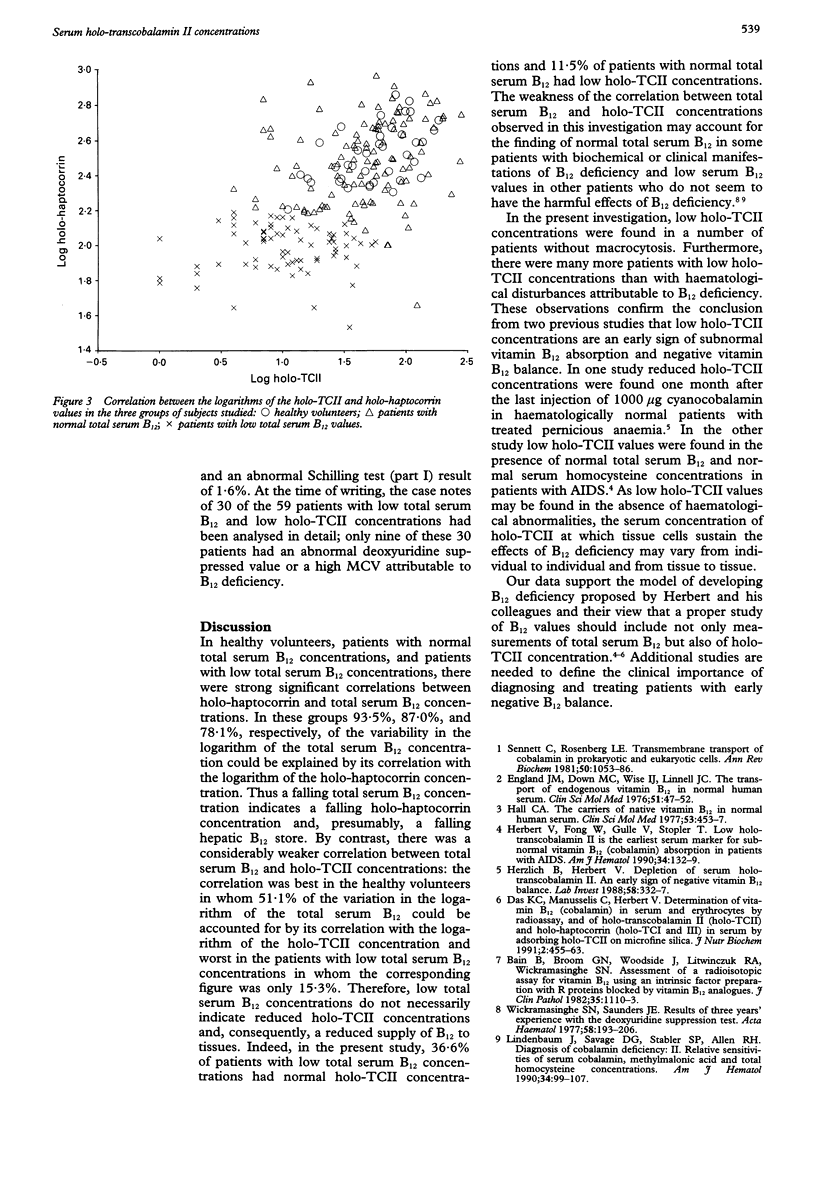Abstract
AIMS--To study the correlations between total vitamin B12(B12), holo-haptocorrin, and holo-transcobalamin II (holo-TCII) concentrations in human sera; the association between reduced holo-TCII concentrations and macrocytosis attributable to B12 deficiency. METHODS--Serum samples from 38 healthy volunteers, 113 patients with normal total serum B12 concentrations and 93 patients with low total serum B12 were studied. Holo-TCII was removed from whole serum by adsorption with amorphous precipitated silica, and both whole serum and adsorbed serum were assayed for B12 using the Becton Dickinson vitamin B12 [57Co] radioassay kit. RESULTS--In all three groups of subjects studied there were strong correlations between the logarithms of the total serum B12 and the holo-haptocorrin concentrations with regression coefficients between 0.884 and 0.967. By contrast, the correlations between the logarithms of the total serum B12 and holo-TCII concentrations were weaker, especially in the patients with normal or low total serum B12, for whom the regression coefficients were 0.491 and 0.391, respectively. Analysis of the clinical records of a proportion of the patients studied indicated that there were many more patients with low holo-TCII concentrations than with haematological disturbances related to B12 deficiency. CONCLUSIONS--The total serum B12 concentration is a relatively poor indicator of holo-TCII concentrations and, therefore, of the ability of serum to deliver B12 to tissues. Additional information regarding B12 values can therefore be gleaned from measuring holo-TCII concentrations in the serum. Low holo-TCII concentrations, however, are an early sign of negative B12 balance and are frequently unassociated with haematological abnormalities caused by B12 deficiency.
Full text
PDF


Selected References
These references are in PubMed. This may not be the complete list of references from this article.
- Bain B., Broom G. N., Woodside J., Litwinczuk R. A., Wickramasinghe S. N. Assessment of a radioisotopic assay for vitamin B12 using an intrinsic factor preparation with R proteins blocked by vitamin B12 analogues. J Clin Pathol. 1982 Oct;35(10):1110–1113. doi: 10.1136/jcp.35.10.1110. [DOI] [PMC free article] [PubMed] [Google Scholar]
- England J. M., Down M. C., Wise I. J., Linnell J. C. The transport of endogenous vitamin B12 in normal human serum. Clin Sci Mol Med. 1976 Jul;51(1):47–52. doi: 10.1042/cs0510047. [DOI] [PubMed] [Google Scholar]
- Hall C. A. The carriers of native vitamin B12 in normal human serum. Clin Sci Mol Med. 1977 Nov;53(5):453–457. doi: 10.1042/cs0530453. [DOI] [PubMed] [Google Scholar]
- Herbert V., Fong W., Gulle V., Stopler T. Low holotranscobalamin II is the earliest serum marker for subnormal vitamin B12 (cobalamin) absorption in patients with AIDS. Am J Hematol. 1990 Jun;34(2):132–139. doi: 10.1002/ajh.2830340210. [DOI] [PubMed] [Google Scholar]
- Herzlich B., Herbert V. Depletion of serum holotranscobalamin II. An early sign of negative vitamin B12 balance. Lab Invest. 1988 Mar;58(3):332–337. [PubMed] [Google Scholar]
- Lindenbaum J., Savage D. G., Stabler S. P., Allen R. H. Diagnosis of cobalamin deficiency: II. Relative sensitivities of serum cobalamin, methylmalonic acid, and total homocysteine concentrations. Am J Hematol. 1990 Jun;34(2):99–107. doi: 10.1002/ajh.2830340205. [DOI] [PubMed] [Google Scholar]
- Sennett C., Rosenberg L. E., Mellman I. S. Transmembrane transport of cobalamin in prokaryotic and eukaryotic cells. Annu Rev Biochem. 1981;50:1053–1086. doi: 10.1146/annurev.bi.50.070181.005201. [DOI] [PubMed] [Google Scholar]
- Wickramasinghe S. N., Saunders J. E. Results of three years' experience with the deoxyuridine suppression test. Acta Haematol. 1977;58(4):193–206. doi: 10.1159/000207828. [DOI] [PubMed] [Google Scholar]


